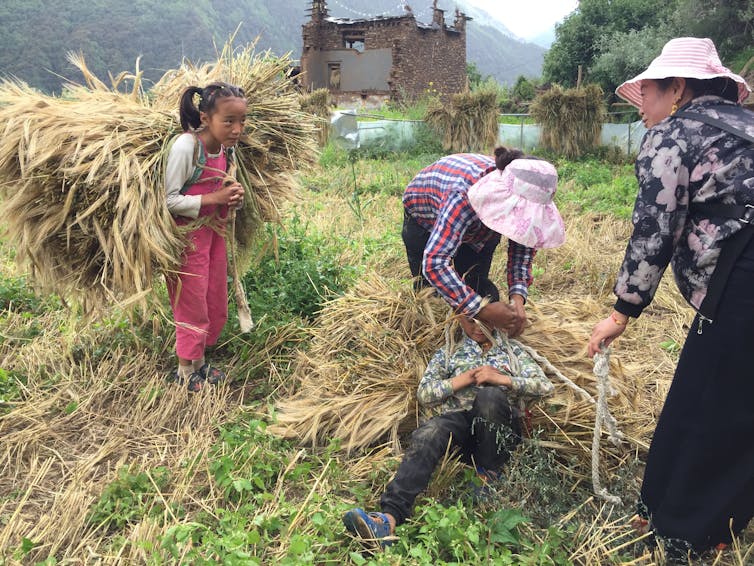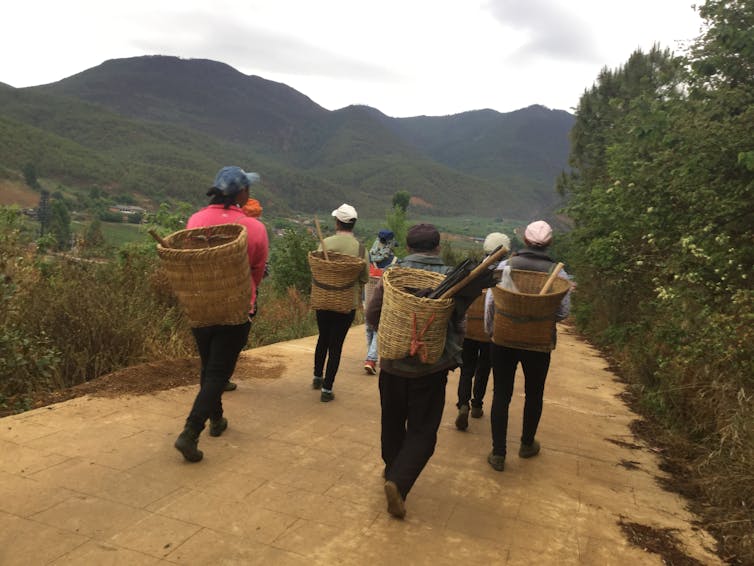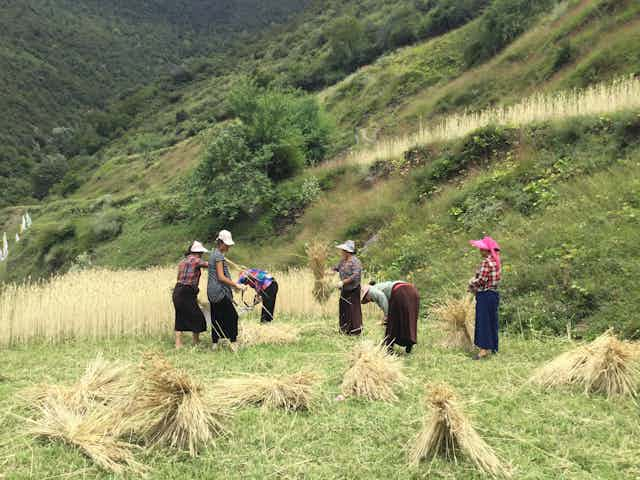For most people around the world, physical work takes up a great amount of time and energy every day. But what determines whether it is men or women who are working harder in households? In most hunter-gatherer societies, men are the hunters and women are the gatherers – with men seemingly walking the furthest. But what’s the labour breakdown in other societies?
You can listen to more articles from The Conversation, narrated by Noa, here.
We carried out a study of farming and herding groups in the Tibetan borderlands in rural China – an area with huge cultural diversity – to uncover which factors actually determine who works the hardest in a household, and why. Our results, published in Current Biology, shed light on the gender division of work across many different kinds of society.
The majority of adults across the world are married. Marriage is a contract, so one might expect roughly equal costs and benefits from the union for both parties. But unequal bargaining power in a household – such as one person threatening divorce – can lead to unequal contributions to the partnership.
Leaving home
We decided to test the hypothesis that leaving your natal area after heterosexual marriage to live with your spouse’s family may contribute to a higher level of workload. In such marriages, the new person typically isn’t related to, and doesn’t share a history with, anyone in their new household. Without blood relatives around them, they might therefore be at a disadvantage when it comes to bargaining power.

The most common form of marriage around the world is where women are the “dispersers”, leaving their native home, while men stay with their families in their natal area. This is known as patrilocality.
Neolocality – in which both sexes disperse at marriage, and the couple lives in a new place away from both their families – is another common practice in many parts of the world. Matrilocality – where women stay in the natal family and men move to live with the wife and her family – is quite rare. And duolocality – where neither sex leaves home and husband and wife live apart – is very rarely seen.
Luckily, in the diverse Tibetan borderlands, all four of these different dispersal patterns can be found across various different ethnic groups.
Our study focused on rural villages from six different ethnic cultures. With our collaborators from Lanzhou University in China, we interviewed more than 500 people about their dispersal status after marriage, and invited them to wear an activity tracker (like a fitbit) to assess their workloads.
Women work harder
Our first finding was that women worked much harder than men, and contributed most of the fruits of this labour to their families. This was evidenced both by their own reports of how much they worked and by their activity trackers.
Women walked on average just over 12,000 steps per day, while men walked just over 9,000 steps. So men also worked hard, but less so than women. They spent more time in leisure or social activities, or just hanging around and resting.
This may be partly because women are, on average, physically weaker than men, and may thus have reduced bargaining power. But we also found that individuals (be they male or female) who disperse at marriage to live away from their kin have higher workloads than those who stay with their natal families.
So if you are female and move away from home at marriage (as most women do throughout the world), you suffer not just in terms of missing your own family but also in terms of workload. When both sexes disperse and no one lives with their natal families, both sexes work hard (as there is little help from kin) – but the woman still works harder. According to our study, perfect sex equality in workload only occurs in instances where men disperse and women do not.
These results help us to understand why women globally disperse, but men generally do not. Dispersal is especially bad for men – adding about 2,000 more steps per day to their step count, but only adding about 1,000 steps per day for women.

Time and energy spent on farming, herding and housework competes with free time. So substantial labour contribution to households in these rural areas can result in less time spent on rest. From an evolutionary view, giving up rest isn’t favourable unless it contributes to higher fitness – such as enhancing offspring survival.
We don’t actually know whether it is favourable in this case, as it hasn’t been researched much. It may be true in poor and rural areas around the world, but less so in wealthier settings.
In most urban areas, for example, an inactive lifestyle is becoming more pervasive. And research has shown that sedentary lifestyles in such areas among white-collar workers are becoming a significant public health issue. They are linked to many chronic health conditions such as obesity, infertility, and several mental health disorders.
Sex inequality in workload persists both in the home and outside. Now our study has given an evolutionary perspective on why women are more likely than men to be bearing a heavy work burden.
But things are slowly changing. As women are increasingly starting families away from both their partner’s and their own family, their bargaining power is increasing. This is further boosted by their increasing levels of self-generated wealth, education and autonomy. Ultimately, these changes are leading men to take on an increasing workload in many urban, industrial or post-industrial societies.


